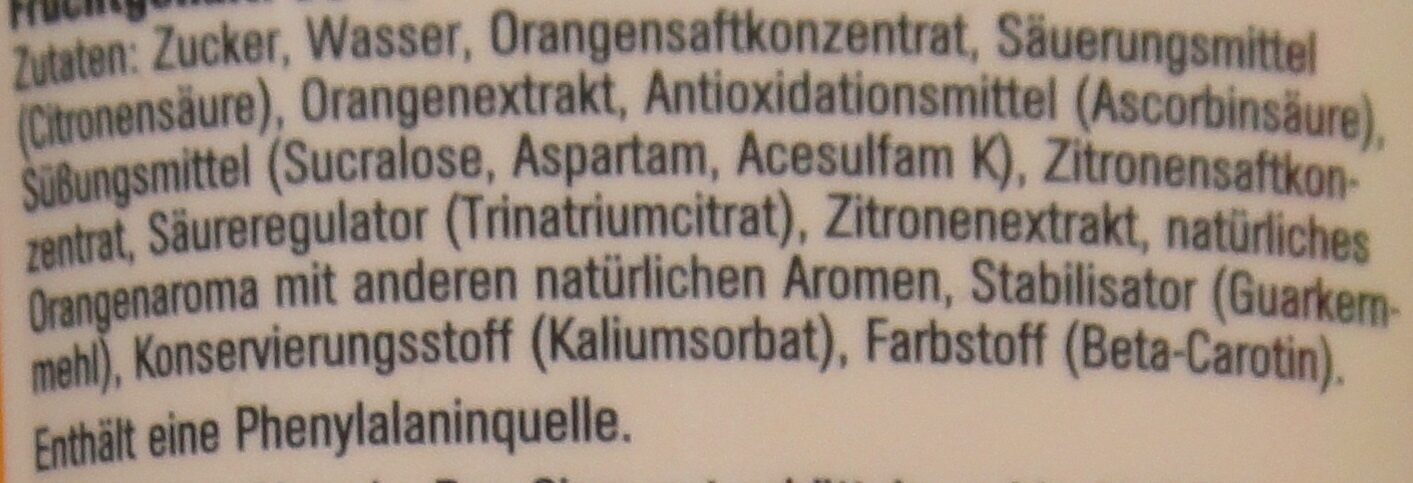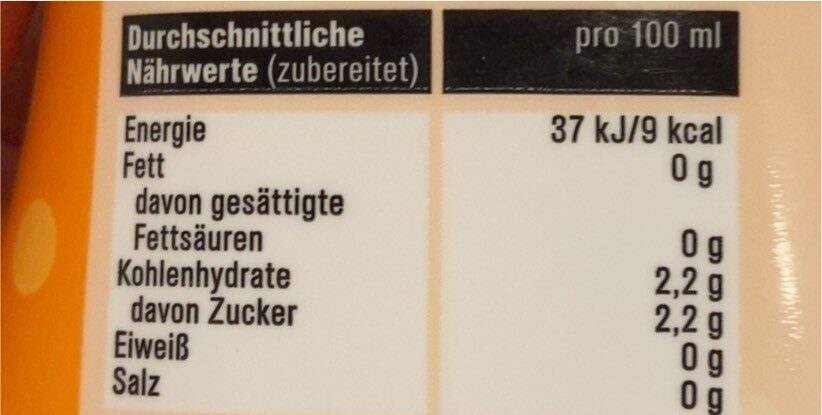Help us make food transparency the norm!
As a non-profit organization, we depend on your donations to continue informing consumers around the world about what they eat.
The food revolution starts with you!
Getränke Sirup mit Orangengeschmack - Penny - 500 ml
Getränke Sirup mit Orangengeschmack - Penny - 500 ml
Ambiguous barcode: This product has a Restricted Circulation Number barcode for products within a company. This means that different producers and stores can use the same barcode for different products.
×
This product page is not complete. You can help to complete it by editing it and adding more data from the photos we have, or by taking more photos using the app for Android or iPhone/iPad. Thank you!
×
Barcode: 21334313
Common name: Getränkesirup mit Orangengeschmack mit Zucker und Süßungsmitteln
Quantity: 500 ml
Packaging: Plastic, Hdpe-high-density-polyethylene, Bottle, Label, Lid, Pp-polypropylene
Brands: Penny
Categories: Beverages, Syrups, Flavoured syrups, Orange syrups
Labels, certifications, awards:
Vegetarian, Vegan, Contains a source of phenylalanine, European Vegetarian Union, European Vegetarian Union Vegan, Nutriscore, Nutriscore Grade C

Origin of ingredients: Netherlands, de:Creme de la Cream Company B.V., de:Zaandam
Manufacturing or processing places: Zaandam, Die Niederlande
Stores: Penny
Countries where sold: Germany
Matching with your preferences
Health
Ingredients
-
23 ingredients
: Zucker, Wasser, Orangensaftkonzentrat, Säuerungsmittel (Citronensäure), Orangenextrakt, Antioxidationsmittel (Ascorbinsäure), Süßungsmittel (Sucralose, Aspartam, Acesulfam K), Zitronensaftkonzentrat, Säureregulator (Trinatriumcitrat), Zitronenextrakt, natürliches Orangenaroma mit anderen natürlichen Aromen, Stabilisator (Guarkernmehl), Konservierungsstoff (Kaliumsorbat), Farbstoff (Beta-Carotin)
Food processing
-
Ultra processed foods
Elements that indicate the product is in the 4 - Ultra processed food and drink products group:
- Additive: E160a - Carotene
- Additive: E412 - Guar gum
- Additive: E950 - Acesulfame k
- Additive: E951 - Aspartame
- Additive: E955 - Sucralose
- Ingredient: Colour
- Ingredient: Flavouring
- Ingredient: Sweetener
Food products are classified into 4 groups according to their degree of processing:
- Unprocessed or minimally processed foods
- Processed culinary ingredients
- Processed foods
- Ultra processed foods
The determination of the group is based on the category of the product and on the ingredients it contains.
Additives
-
E160a - Carotene
Carotene: The term carotene -also carotin, from the Latin carota, "carrot"- is used for many related unsaturated hydrocarbon substances having the formula C40Hx, which are synthesized by plants but in general cannot be made by animals -with the exception of some aphids and spider mites which acquired the synthesizing genes from fungi-. Carotenes are photosynthetic pigments important for photosynthesis. Carotenes contain no oxygen atoms. They absorb ultraviolet, violet, and blue light and scatter orange or red light, and -in low concentrations- yellow light. Carotenes are responsible for the orange colour of the carrot, for which this class of chemicals is named, and for the colours of many other fruits, vegetables and fungi -for example, sweet potatoes, chanterelle and orange cantaloupe melon-. Carotenes are also responsible for the orange -but not all of the yellow- colours in dry foliage. They also -in lower concentrations- impart the yellow coloration to milk-fat and butter. Omnivorous animal species which are relatively poor converters of coloured dietary carotenoids to colourless retinoids have yellowed-coloured body fat, as a result of the carotenoid retention from the vegetable portion of their diet. The typical yellow-coloured fat of humans and chickens is a result of fat storage of carotenes from their diets. Carotenes contribute to photosynthesis by transmitting the light energy they absorb to chlorophyll. They also protect plant tissues by helping to absorb the energy from singlet oxygen, an excited form of the oxygen molecule O2 which is formed during photosynthesis. β-Carotene is composed of two retinyl groups, and is broken down in the mucosa of the human small intestine by β-carotene 15‚15'-monooxygenase to retinal, a form of vitamin A. β-Carotene can be stored in the liver and body fat and converted to retinal as needed, thus making it a form of vitamin A for humans and some other mammals. The carotenes α-carotene and γ-carotene, due to their single retinyl group -β-ionone ring-, also have some vitamin A activity -though less than β-carotene-, as does the xanthophyll carotenoid β-cryptoxanthin. All other carotenoids, including lycopene, have no beta-ring and thus no vitamin A activity -although they may have antioxidant activity and thus biological activity in other ways-. Animal species differ greatly in their ability to convert retinyl -beta-ionone- containing carotenoids to retinals. Carnivores in general are poor converters of dietary ionone-containing carotenoids. Pure carnivores such as ferrets lack β-carotene 15‚15'-monooxygenase and cannot convert any carotenoids to retinals at all -resulting in carotenes not being a form of vitamin A for this species-; while cats can convert a trace of β-carotene to retinol, although the amount is totally insufficient for meeting their daily retinol needs.Source: Wikipedia
-
E160ai - Beta-carotene
Beta-Carotene: β-Carotene is an organic, strongly colored red-orange pigment abundant in plants and fruits. It is a member of the carotenes, which are terpenoids -isoprenoids-, synthesized biochemically from eight isoprene units and thus having 40 carbons. Among the carotenes, β-carotene is distinguished by having beta-rings at both ends of the molecule. β-Carotene is biosynthesized from geranylgeranyl pyrophosphate.β-Carotene is the most common form of carotene in plants. When used as a food coloring, it has the E number E160a. The structure was deduced by Karrer et al. in 1930. In nature, β-carotene is a precursor -inactive form- to vitamin A via the action of beta-carotene 15‚15'-monooxygenase.Isolation of β-carotene from fruits abundant in carotenoids is commonly done using column chromatography. It can also be extracted from the beta-carotene rich algae, Dunaliella salina. The separation of β-carotene from the mixture of other carotenoids is based on the polarity of a compound. β-Carotene is a non-polar compound, so it is separated with a non-polar solvent such as hexane. Being highly conjugated, it is deeply colored, and as a hydrocarbon lacking functional groups, it is very lipophilic.Source: Wikipedia
-
E202 - Potassium sorbate
Potassium sorbate (E202) is a synthetic food preservative commonly used to extend the shelf life of various food products.
It works by inhibiting the growth of molds, yeast, and some bacteria, preventing spoilage. When added to foods, it helps maintain their freshness and quality.
Some studies have shown that when combined with nitrites, potassium sorbate have genotoxic activity in vitro. However, potassium sorbate is generally recognized as safe (GRAS) by regulatory authorities.
-
E330 - Citric acid
Citric acid is a natural organic acid found in citrus fruits such as lemons, oranges, and limes.
It is widely used in the food industry as a flavor enhancer, acidulant, and preservative due to its tart and refreshing taste.
Citric acid is safe for consumption when used in moderation and is considered a generally recognized as safe (GRAS) food additive by regulatory agencies worldwide.
-
E331 - Sodium citrates
Sodium citrate: Sodium citrate may refer to any of the sodium salts of citrate -though most commonly the third-: Monosodium citrate Disodium citrate Trisodium citrateThe three forms of the salt are collectively known by the E number E331. Sodium citrates are used as acidity regulators in food and drinks, and also as emulsifiers for oils. They enable cheeses to melt without becoming greasy.Source: Wikipedia
-
E331iii - Trisodium citrate
Sodium citrate: Sodium citrate may refer to any of the sodium salts of citrate -though most commonly the third-: Monosodium citrate Disodium citrate Trisodium citrateThe three forms of the salt are collectively known by the E number E331. Sodium citrates are used as acidity regulators in food and drinks, and also as emulsifiers for oils. They enable cheeses to melt without becoming greasy.Source: Wikipedia
-
E412 - Guar gum
Guar gum (E412) is a natural food additive derived from guar beans.
This white, odorless powder is valued for its remarkable thickening and stabilizing properties, making it a common ingredient in various food products, including sauces, dressings, and ice creams.
When used in moderation, guar gum is considered safe for consumption, with no known adverse health effects.
-
E950 - Acesulfame k
Acesulfame potassium: Acesulfame potassium - AY-see-SUL-faym-, also known as acesulfame K -K is the symbol for potassium- or Ace K, is a calorie-free sugar substitute -artificial sweetener- often marketed under the trade names Sunett and Sweet One. In the European Union, it is known under the E number -additive code- E950. It was discovered accidentally in 1967 by German chemist Karl Clauss at Hoechst AG -now Nutrinova-. In chemical structure, acesulfame potassium is the potassium salt of 6-methyl-1‚2,3-oxathiazine-4-3H--one 2‚2-dioxide. It is a white crystalline powder with molecular formula C4H4KNO4S and a molecular weight of 201.24 g/mol.Source: Wikipedia
-
E951 - Aspartame
Aspartame: Aspartame -APM- is an artificial non-saccharide sweetener used as a sugar substitute in some foods and beverages. In the European Union, it is codified as E951. Aspartame is a methyl ester of the aspartic acid/phenylalanine dipeptide. A panel of experts set up by the European Food Safety Authority concluded in 2013 that aspartame is safe for human consumption at current levels of exposure. As of 2018, evidence does not support a long-term benefit for weight loss or in diabetes. Because its breakdown products include phenylalanine, people with the genetic condition phenylketonuria -PKU- must be aware of this as an additional source.It was first sold under the brand name NutraSweet. It was first made in 1965, and the patent expired in 1992. It was initially approved for use in food products by the U.S. Food and Drug Administration -FDA- in 1981. The safety of aspartame has been the subject of several political and medical controversies, United States congressional hearings, and Internet hoaxes.Source: Wikipedia
-
E955 - Sucralose
Sucralose: Sucralose is an artificial sweetener and sugar substitute. The majority of ingested sucralose is not broken down by the body, so it is noncaloric. In the European Union, it is also known under the E number E955. It is produced by chlorination of sucrose. Sucralose is about 320 to 1‚000 times sweeter than sucrose, three times as sweet as both aspartame and acesulfame potassium, and twice as sweet as sodium saccharin. Evidence of benefit is lacking for long-term weight loss with some data supporting weight gain and heart disease risks.It is stable under heat and over a broad range of pH conditions. Therefore, it can be used in baking or in products that require a long shelf life. The commercial success of sucralose-based products stems from its favorable comparison to other low-calorie sweeteners in terms of taste, stability, and safety. Common brand names of sucralose-based sweeteners are Splenda, Zerocal, Sukrana, SucraPlus, Candys, Cukren, and Nevella. Canderel Yellow also contains sucralose, but the original Canderel and Green Canderel do not.Source: Wikipedia
Ingredients analysis
-
May contain palm oil
Ingredients that may contain palm oil: E160ai
-
Vegan
No non-vegan ingredients
-
Vegetarian
No non-vegetarian ingredients detected
-
Details of the analysis of the ingredients
: Zucker, Wasser, Orangensaftkonzentrat, Säuerungsmittel (Citronensäure), Orangenextrakt, Antioxidationsmittel (Ascorbinsäure), Süßungsmittel (Sucralose, Aspartam, Acesulfam K), Zitronensaftkonzentrat, Säureregulator (Trinatriumcitrat), Zitronenextrakt, natürliches Orangenaroma mit anderen natürlichen Aromen, Stabilisator (Guarkernmehl), Konservierungsstoff (Kaliumsorbat), Farbstoff (Beta-Carotin)- Zucker -> en:sugar - vegan: yes - vegetarian: yes - ciqual_proxy_food_code: 31016 - percent_min: 7.14285714285714 - percent_max: 100
- Wasser -> en:water - vegan: yes - vegetarian: yes - ciqual_food_code: 18066 - percent_min: 0 - percent_max: 50
- Orangensaftkonzentrat -> en:concentrated-orange-juice - vegan: yes - vegetarian: yes - ciqual_proxy_food_code: 2070 - percent_min: 0 - percent_max: 33.3333333333333
- Säuerungsmittel -> en:acid - percent_min: 0 - percent_max: 25
- Citronensäure -> en:e330 - vegan: yes - vegetarian: yes - percent_min: 0 - percent_max: 25
- Orangenextrakt -> en:orange-extract - vegan: maybe - vegetarian: maybe - percent_min: 0 - percent_max: 5
- Antioxidationsmittel -> en:antioxidant - percent_min: 0 - percent_max: 5
- Ascorbinsäure -> en:e300 - vegan: yes - vegetarian: yes - percent_min: 0 - percent_max: 5
- Süßungsmittel -> en:sweetener - percent_min: 0 - percent_max: 5
- Sucralose -> en:e955 - vegan: yes - vegetarian: yes - percent_min: 0 - percent_max: 5
- Aspartam -> en:e951 - vegan: yes - vegetarian: yes - percent_min: 0 - percent_max: 2.5
- Acesulfam K -> en:e950 - vegan: yes - vegetarian: yes - percent_min: 0 - percent_max: 1.66666666666667
- Zitronensaftkonzentrat -> en:concentrated-lemon-juice - vegan: yes - vegetarian: yes - ciqual_food_code: 2028 - percent_min: 0 - percent_max: 5
- Säureregulator -> en:acidity-regulator - percent_min: 0 - percent_max: 5
- Trinatriumcitrat -> en:e331iii - vegan: yes - vegetarian: yes - percent_min: 0 - percent_max: 5
- Zitronenextrakt -> en:lemon-extract - vegan: yes - vegetarian: yes - ciqual_proxy_food_code: 13009 - percent_min: 0 - percent_max: 5
- natürliches Orangenaroma mit anderen natürlichen Aromen -> fr:aromes-naturels-d-orange-avec-autres-aromes-naturels - vegan: maybe - vegetarian: maybe - percent_min: 0 - percent_max: 5
- Stabilisator -> en:stabiliser - percent_min: 0 - percent_max: 5
- Guarkernmehl -> en:e412 - vegan: yes - vegetarian: yes - percent_min: 0 - percent_max: 5
- Konservierungsstoff -> en:preservative - percent_min: 0 - percent_max: 5
- Kaliumsorbat -> en:e202 - vegan: yes - vegetarian: yes - percent_min: 0 - percent_max: 5
- Farbstoff -> en:colour - percent_min: 0 - percent_max: 5
- Beta-Carotin -> en:e160ai - vegan: maybe - vegetarian: maybe - from_palm_oil: maybe - percent_min: 0 - percent_max: 5
Nutrition
-
Average nutritional quality
⚠ ️Warning: the amounts of fiber and of fruits, vegetables and nuts are not specified, their possible positive contribution to the grade could not be taken into account.This product is considered a beverage for the calculation of the Nutri-Score.
Positive points: 0
- Proteins: 0 / 5 (value: 0, rounded value: 0)
- Fiber: 0 / 5 (value: 0, rounded value: 0)
- Fruits, vegetables, nuts, and colza/walnut/olive oils: 0 / 10 (value: 0, rounded value: 0)
Negative points: 4
- Energy: 2 / 10 (value: 37, rounded value: 37)
- Sugars: 2 / 10 (value: 2.2, rounded value: 2.2)
- Saturated fat: 0 / 10 (value: 0, rounded value: 0)
- Sodium: 0 / 10 (value: 0, rounded value: 0)
The points for proteins are counted because the negative points are less than 11.
Nutritional score: (4 - 0)
Nutri-Score:
-
Nutrient levels
-
Fat in low quantity (0%)
What you need to know- A high consumption of fat, especially saturated fats, can raise cholesterol, which increases the risk of heart diseases.
Recommendation: Limit the consumption of fat and saturated fat- Choose products with lower fat and saturated fat content.
-
Saturated fat in low quantity (0%)
What you need to know- A high consumption of fat, especially saturated fats, can raise cholesterol, which increases the risk of heart diseases.
Recommendation: Limit the consumption of fat and saturated fat- Choose products with lower fat and saturated fat content.
-
Sugars in low quantity (2.2%)
What you need to know- A high consumption of sugar can cause weight gain and tooth decay. It also augments the risk of type 2 diabetes and cardio-vascular diseases.
Recommendation: Limit the consumption of sugar and sugary drinks- Sugary drinks (such as sodas, fruit beverages, and fruit juices and nectars) should be limited as much as possible (no more than 1 glass a day).
- Choose products with lower sugar content and reduce the consumption of products with added sugars.
-
Salt in low quantity (0%)
What you need to know- A high consumption of salt (or sodium) can cause raised blood pressure, which can increase the risk of heart disease and stroke.
- Many people who have high blood pressure do not know it, as there are often no symptoms.
- Most people consume too much salt (on average 9 to 12 grams per day), around twice the recommended maximum level of intake.
Recommendation: Limit the consumption of salt and salted food- Reduce the quantity of salt used when cooking, and don't salt again at the table.
- Limit the consumption of salty snacks and choose products with lower salt content.
-
-
Nutrition facts
Nutrition facts As sold
for 100 g / 100 mlPrepared
for 100 g / 100 mlCompared to: Orange syrups Energy 37 kj
(9 kcal)37 kj
(9 kcal)-96% Fat 0 g 0 g -100% Saturated fat 0 g 0 g -100% Carbohydrates 2.2 g 2.2 g -96% Sugars 2.2 g 2.2 g -96% Fiber ? ? Proteins 0 g 0 g -100% Salt 0 g 0 g -100% Fruits‚ vegetables‚ nuts and rapeseed‚ walnut and olive oils (estimate from ingredients list analysis) 12.123 % ?
Environment
-
Eco-Score A - Very low environmental impact
⚠ ️Select a country in order to include the full impact of transportation.The Eco-Score is an experimental score that summarizes the environmental impacts of food products.→ The Eco-Score was initially developped for France and it is being extended to other European countries. The Eco-Score formula is subject to change as it is regularly improved to make it more precise and better suited to each country.Life cycle analysis
-
Average impact of products of the same category: A (Score: 100/100)
Category: Syrup (mint, strawberries flavouredetc.), with sugar diluted in water
Category: Syrup (mint, strawberries flavouredetc.), with sugar diluted in water
- PEF environmental score: 0.02 (the lower the score, the lower the impact)
- including impact on climate change: 0.10 kg CO2 eq/kg of product
Stage Impact Agriculture
53.2 %Processing
7.4 %Packaging
27.4 %Transportation
7.4 %Distribution
3.2 %Consumption
1.4 %
Bonuses and maluses
-
Origins of ingredients with a medium impact
Bonus: +3
Environmental policy: +3
Transportation: 0
Origin of the product and/or its ingredients % of ingredients Impact Netherlands 100 %Medium
-
Packaging with a medium impact
Malus: -8
Shape Material Recycling Impact 1 Bottle HDPE 2 - High-density polyethylene Discard Medium 1 Lid PP 5 - Polypropylene Discard High 1 Label Plastic Discard High
Eco-Score for this product
-
Impact for this product: A (Score: 95/100)
Product: Getränke Sirup mit Orangengeschmack - Penny - 500 ml
Life cycle analysis score: 100
Sum of bonuses and maluses: -5
Final score: 95/100
-
Carbon footprint
-
Equal to driving 0.1 km in a petrol car
10 g CO² per 100g of product
The carbon emission figure comes from ADEME's Agribalyse database, for the category: Syrup (mint, strawberries flavouredetc.), with sugar diluted in water (Source: ADEME Agribalyse Database)
Stage Impact Agriculture
33.0 %Processing
19.9 %Packaging
26.0 %Transportation
18.6 %Distribution
2.2 %Consumption
0.3 %
Packaging
-
Packaging with a medium impact
-
Packaging parts
1 x Bottle 500 ml (HDPE 2 - High-density polyethylene)
1 x Lid (PP 5 - Polypropylene)
1 x Label (Plastic)
-
Packaging materials
Material % Packaging weight Packaging weight per 100 g of product Plastic
-
Transportation
-
Origins of ingredients
Origins of ingredients with a medium impact
Origin of the product and/or its ingredients % of ingredients Impact Netherlands 100 %Medium
Report a problem
-
Incomplete or incorrect information?
Category, labels, ingredients, allergens, nutritional information, photos etc.
If the information does not match the information on the packaging, please complete or correct it. Open Food Facts is a collaborative database, and every contribution is useful for all.
Data sources
Product added on by twindel
Last edit of product page on by jaghj.
Product page also edited by ecoscore-impact-estimator, kiliweb, professordoc, worldtest, yuka.sY2b0xO6T85zoF3NwEKvlnNJaejsviv5CxrRqBym4IeUMofjWN9e6NfxCas.









